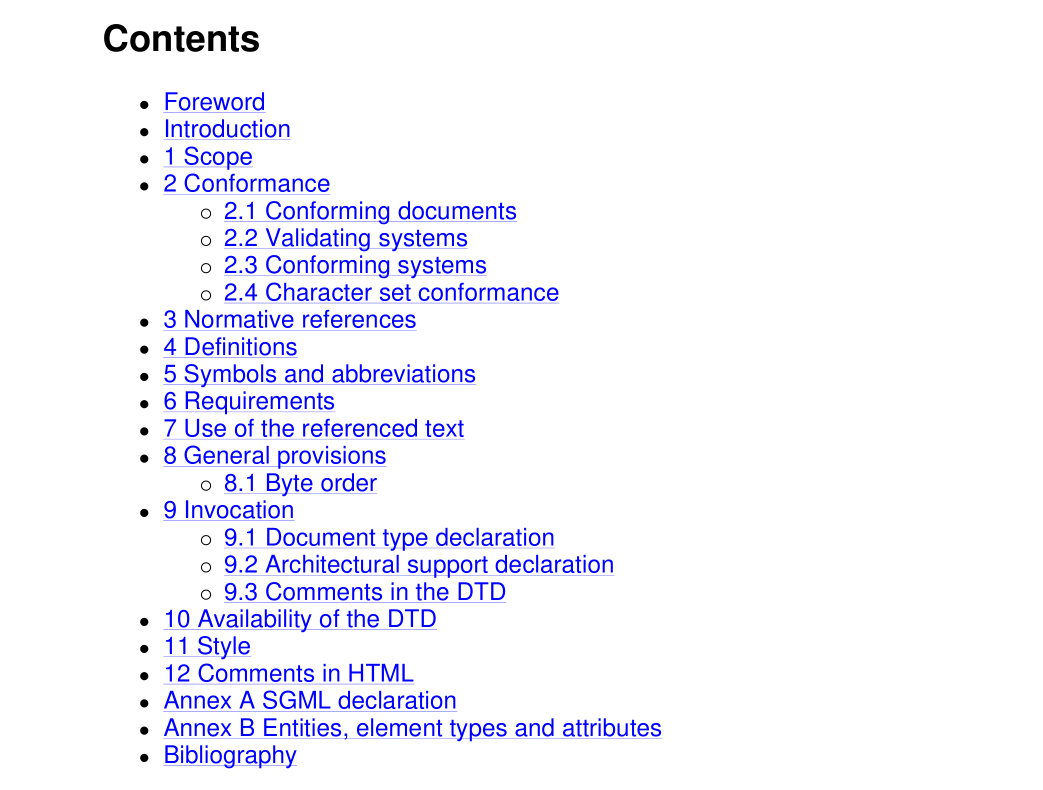ISO IEC 15445 pdf download

ISO IEC 15445 pdf download.Information technology — Document description and processing languages — HyperText Markup Language (HTML)
4 Definitions
For the purposes of this International Standard, the definitions given in ISO 8879:1 986 and the following definitions apply: 4.1 Browser A user agent whose main function is to present documents to a user. 4.2 Character (Source: RFC1866) An atom of information, for example a letter or a digit. Graphic characters have associated glyphs, whereas control characters have associated processing semantics. 4.3 Character encoding scheme (Source: RFC1866) A function whose domain is the set of sequences of octets, and whose range is the set of sequences of characters from a character repertoire; that is, a sequence of octets and a character encoding scheme determining a sequence of characters. 4.4 Character repertoire (Source: RFC1866) A finite set of characters; eg. the range of a coded character set. 4.5 Code position (Source: RFC1866) An integer in the domain of a coded character set. The coded character set maps the code position to a character. 4.6 Coded character set (Source: RFC1866) A function whose domain is a subset of the integers and whose range is a character repertoire; that is, for some set of integers (usually of the form {0, 1 , 2, …, N-1 }), a coded character set and an integer in that set determine a character. Conversely, a character and a coded character set determine the character’s code position (or, in rare cases, a few code positions). 4.7 CRLF (Source: RFC2046) The sequence of the two ISO/IEC 646:1 991 characters CR (1 3) and LF (1 0) which, taken together, in this order, denote a line break. 4.8 Form data set (Source: RFC1866) A sequence of name/value pairs; the names given by an HTML document and the values given by the user. 4.9 Fragment identifier (Source: RFC1866) The portion of an HREF attribute value following the `#’ character. 4.1 0 HTML browser A browser which presents HTML documents. 4.1 1 HTML document A document structured in accordance with this International Standard. 4.1 2 Hyperlink A relationship between two anchors, called the source and the target. The link goes from the source to the target. The source is also known as the tail, and the target is also known as the destination or head. 4.1 3 User Agent (in the World Wide Web) A software or hardware device which accepts user input and presents to the user the World Wide Web’s interpretation of that input.
7 Use of the referenced text
The set of element types provided by this International Standard is a subset of the set of element [type]s defined by the W3C Recommendation for HTML 4.0. The set of attributes provided for each element type included in this International Standard is a subset of the corresponding set defined by the W3C Recommendation for HTML 4.0. The set of element types and the sets of attributes are defined by the DTD provided with this International Standard. Where refinements are defined for element types and attributes, the semantics are a subset of the semantics defined by the W3C Recommendation for HTML 4.0 in the sense that the set of documents conforming to this International Standard is a subset of those conforming to the W3C Recommendation for HTML 4.0. NOTE: For clarity, and as required by ISO 8879, this International Standard makes a distinction between an individual element with a given generic identifier and the class of all such elements. The class is called an element type, the instance is called an element and the generic identifier is called an element type name.









